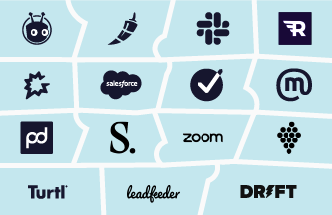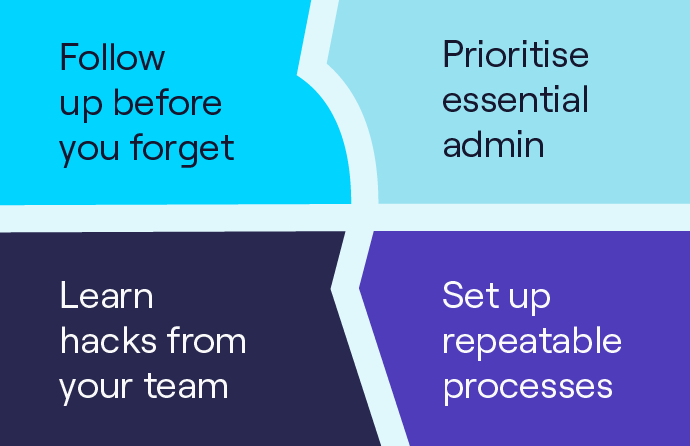Intent Data: What It Is, How It’s Collected, and 7 Ways to Use It
Staying ahead in B2B needs more than your conventional strategies.
This is where intent data comes into play – a revolutionary concept that can reshape how businesses approach their outbound strategies.
This comprehensive guide delves into intent data, its significance, and how to use it to power your sales and marketing teams.
Let’s start 👇
What is intent data?
Intent data provides insights into the online behaviours of a target audience. It’s also known as buyer intent data or purchase intent data. It predicts whether a buyer will buy a solution or product in your category.
Sales and marketing teams can use intent signals to make more efficient decisions, but it’s not often used to its full potential.
Think of B2B intent data as the behavioural breadcrumbs that users leave behind as they navigate the digital realm. The breadcrumbs provide invaluable insights into what users are seeking, what problems they need to solve, and what solutions they are exploring.
Discover the meaning of intent data and how it helps B2B sales! Press ▶️ to watch Cognism’s explainer video.
The different types of intent data & how they are collected
To effectively leverage customer intent, you must understand the different types of intent data and where it comes from. There are two main areas: first-party and third-party intent data.
- First-party intent data is any data collected from your site. This could include forms filled in for gated content, website analytics, customer interactions, and outbound emails or social media.
- Third-party intent data is any data collected from another website. This includes reverse IP tracking, data aggregator, and content consumption. Intent data providers, such as Cognism’s partner Bombora, gather it and provide it to buyers.
We’ve broken this down in a handy cheat sheet for you to steal 👇
/Intent%20data/intent-data-infographic.webp?width=630&height=600&name=intent-data-infographic.webp)
There are four types of intent data sources:
1. Search intent data
This data is collected when a potential customer searches for a keyword or phrase on a search engine like Google. You can use search intent data to identify the topics your target audience is searching for, allowing you to provide the most relevant answers to their questions.
For instance, if you sell sales intelligence software, you can find companies searching for “How can I make prospecting easier?”.
This shows customer intent; you can reach out with your solution before your competitors.
2. Engagement data
This data refers to prospective buyers’ engagement with specific content, including reading, sharing, or commenting activities. Engagement data is collected from lead source channels such as your blog, website, LinkedIn, Facebook or Twitter.
An example of this is dark social. A prospect will share a valuable piece of content from your company on social media, including sources you can’t easily track, such as Facebook Messenger. You can use this information to share more of their favourite content or attempt a sales conversion.
3. Firmographic data
This is data about a prospective company. Firmographic information includes company size, location, industry and revenue. The data is usually obtained from business directories, website forms, and B2B data providers.
A good idea is to combine firmographics and ABM to target companies strategically with a higher likelihood of conversion.
For example, firmographics can help you find and target your ideal customer based on industry and company size.
4. Technographic data
Technographic data includes a company’s software, hardware, and networks. It’s often collected via surveys, questionnaires, and polls. These help you better understand a target company’s technical capabilities and needs.
For instance, if you sell B2B data, it’s essential to know if potential customers have an outdated CRM system or are using a competing tool. If you know this, they likely have outdated data, too, and you can offer them data enrichment or sell your tool as a better option.
Here’s an example of intent data being used to target the right customers at the right time:

Sales Manager EMEA @Keboola
What makes a good intent data provider?
Consider these four core factors to find a good B2B intent data provider:
- Data freshness: How often is the data refreshed? If it’s not often enough, the sales intent is in the past tense and will pass you by. The moment of the prospect potentially coming in-market has gone.
- Breadth and depth of signals: How many buyer signals does the provider offer? For example, combining intent topics with funding signals is more effective than relying on one indicator of intent to buy.
- How flexibly you can choose your intent signals: How easy is it to change your focus? Flexibility will mean that you can focus on what’s most important to you and the way your customers research.
- The display of intent within the platform: Intent must be part of your sales and marketing workflows within your data platform. Cognism, for example, displays intent signals directly in the Sales Companion Browser extension, making it easy for reps to use the data while making cold calls.
.webp?width=400&height=579&name=sales-companion-web-graphics%20(1).webp)
Evaluate providers: Compare Cognism vs ZoomInfo, vs Apollo, vs Lusha for intent data
- Cognism: Gets intent data from Bombora, a consent-based collection method from a cooperative of 5,000 B2B sites, where buys actively research a topic when they are ready to make a purchase.
- ZoomInfo: Believed to rely on bidstream data and uses machine learning technology to determine buying signals.
- Apollo.io: Uses LeadSift intent data, which is gathered through account intent, custom search terms, and public web scraping.
- Lusha: Has an integration with Bombora, however intent data is limited to five topics unless you’re on the Scale plan.
7 ways sales & marketing teams can activate intent data
Virtual prospecting intent data can give you the edge over your competitors, giving you better awareness of your market and more context heading into cold calls.
If you’re still unconvinced, here are some ways sales and marketing can activate their intent data.
Activation for B2B sales teams
The ROI potential of sales intent data is staggering. With laser-focused sales strategies, leaders can reduce resource wastage and significantly enhance conversion rates. Let’s get into some GTM plays.
Improve your close rates by getting in first
If you’re the first rep to speak with a high-intent prospect, you’re far more likely to get on the shortlist.
With intent data, you’ll be able to reach potential clients earlier in their buying journey. Your awareness of potential customers just starting to look around means you can target them sooner.
You’re also more likely to find potential buyers unaware of your company. With sales intent data, you’ve got a chance to intercept buyers before they start investigating competitors.
Lead scoring high-intent prospects
If sales teams are identifying many outbound sales leads, they might need more time to reach out to all of them.
This is where lead scoring comes in. It’s the process of prioritising leads so you know who to speak to first.
What’s the best way of scoring leads?
By their intent, of course! If they’re more likely to buy, you want to get on the phone and start pitching to them immediately.
One of the most valuable aspects of contact intent data is that you can rank prospects according to customer intent. This will give you a list of targets, ordered by who to contact first. It’s a lead generation game-changer.
Identify best-fit accounts to boost pipeline
If you can target the best-fit accounts, you’ll generate more pipeline, no doubt.
Intent data gives AEs and sales reps information to find accounts that are more likely to convert. It means you know they have a need at the start of your cold call.
You’ll also build better rapport when you know the prospect’s intent to buy.
Retain more customers and upsell
This might be one for the Customer Success team, but it’s no secret that retaining customers is more cost-effective than finding new ones.
Intent data allows companies to see the solutions their current client base is considering. They might include additional features you don’t yet offer or alternate solutions to your own.
You now have a chance to either work to save the client or add the feature they’re looking for. It’s a great indicator of the gaps in your product, so you can improve your offering over time - and stop your customers from moving elsewhere.
Activation for B2B marketing teams
Marketing intent data is mostly about prioritisation and market discovery. Here are the main use cases:
Build LinkedIn-matched audiences
With the help of ABM intent data, marketers can build effective account based marketing campaigns. Showing relevant ads to the right companies at the right time drastically reduces your cost per lead.
👉 Follow our internal marketing teams’ workflow for LinkedIn matched audiences.
With a better idea of the companies interested in your product, you’ll be presenting ads to familiar faces. People will recognise your brand, and conversions will soar.
This also applies to content marketing.
Just created a handy whitepaper? Great!
Now, you can ensure you’re putting it in front of the right eyes. Which people need to see this content to get a deal over the line? Let’s get it in front of them - by targeting high-intent leads with relevant content at every stage of the B2B marketing funnel.
Improve your target lists
Once you’ve ordered your leads by intent, you’ll better understand your ICP. You’ll know which buyer groups are the most interested. These are the people you want to target.
This feeds into everything a marketer does.
Ensure your team is up to date with intent scoring so they can tailor campaigns to hit the right notes. Intent scoring gives you extra flexibility that isn’t always there with B2B marketing.
With it, your email marketers can build highly relevant lead-nurturing campaigns. Which prospects are ready for a more forward CTA? Which ones need a bit more time? It’s all invaluable information.
Optimise your website
Another benefit of a more accurate ICP is that it allows you to adjust your website to fit your audience and then hyper-target potential customers.
The ICP doesn’t always stay the same. Changes in specific industries might make them a better or worse match. Figuring out your ICP isn’t a one-time job. Intent data allows you to calculate it constantly and make minor adjustments to reflect the change.
This includes optimising your website. For example, you could create pages specifically for the most frequent visitors and those with the highest intent. You could also make relevant case studies accessible and provide industry-specific information.
An example of how marketers can use intent data to generate conversions is Ultima:

Head of Cloud Sales @Ultima

Other ways to use intent data
Data should fuel every business move, and B2B intent data provides actionable insights. From fine-tuning your product offerings to crafting compelling content that addresses user needs, every decision becomes more informed and strategic.
Here are four more ways to use B2B buyer intent data:
- Personalised marketing campaigns: Leverage intent data to craft personalised marketing campaigns that resonate with potential customers’ pain points.
- Content strategy enhancement: Develop content that addresses the queries and concerns expressed through intent data analysis.
- Sales prospecting precision: Equip your sales team with intent data for more meaningful conversations with potential clients.
- Product development alignment: Tailor your product development efforts based on your target audience’s prevalent demands and intentions.
You can use these strategies to leverage intent data. Other steps to use predictive intent data are:
- Data collection: Gather first-party and relevant third-party intent data from various touchpoints.
- Data analysis: Utilise cutting-edge AI-driven tools to analyse the collected data for meaningful patterns.
- Strategy formulation: Develop strategies that align with the identified intentions of your target audience.
- Content creation: Craft content that serves the specific needs expressed through intent data.
- Sales integration: Equip your sales team with intent topics and insights to personalise their approach.

Learn how to use a tool like Cognism’s intent data to target customers searching for a service like yours.
Where to get intent data
The trick to gathering accurate intent data is knowing where to look.
- Known first-party intent data - your CRM.
- Anonymous first-party intent data - Google Analytics.
- Known third-party intent data - Bombora intent data.
- Anonymous third-party intent data - a provider like Bombora or Cognism.
You can use many intent data tools to reach and understand potential customers searching for a solution like yours. Here are some examples:
1. Intent data providers
Cognism, Uplead and ZoomInfo are tools to buy intent data linked to a B2B contact database.
Access to compliant contact-level intent data helps businesses better understand their customers, tailor their offerings, and legally meet customer needs.
2. Co-op intent data
Bombora is a source of co-op intent data. It collects intent data across sites and provides B2B buyers and sales intelligence tools like the above with accurate, GDPR-compliant intent data for lead generation.
Bombora sources its data via consent-based frameworks that respect and protect members’ privacy. 70% of websites in the co-op are exclusive to Bombora.
3. Bidstream intent data
Contact data providers like LeadIQ use bidstream data. Bidstream data is the information publishers collect about their users and the available ad inventory. They then share this data with advertisers who can bid on it.
Frequently asked questions
Here are some FAQs about intent data:
Is Bombora GDPR compliant?
Yes, Bombora’s data is collected through consent-based methods, which ensures it's ethically sourced and GDPR compliant.
What are the benefits of intent data?
The traditional “spray and pray” approach to B2B sales and marketing is ineffective and costly. Intent data emerges as a game-changer in this situation.
Knowing what your potential customers are searching for allows you to tailor your strategies to meet their exact needs.
Intent data bridges the gap between marketing and sales teams, aligning them with customer behaviour. This alignment streamlines processes, leading to higher conversion rates and shorter sales cycles.
Here are the benefits of B2B intent data:
- Prioritise companies based on their buyer intent. Knowing which prospects are most interested in your solution will revolutionise your sales and marketing efforts.
- Identify companies and markets that have shown interest but might not have been on your radar.
- Prioritise existing customers based on intent topics.
- Identify the low-hanging fruit opportunities for higher conversions.
- Learn more about your audience, and build a more detailed ideal customer profile.
These benefits aren’t only true for tech companies. Buyer intent data is highly valuable for any B2B company.
Who sells intent data?
Companies like Bombora, Cognism, and 6Sense sell intent data. The goal of providing their users with intent data is to help them identify prospects who are coming in-market to buy. For this reason, intent data is positioned at sales and marketing teams mostly, but also has uses for customer success and other departments.
What makes Cognism’s intent data unique?
The benefit of having company intent data in a B2B prospecting tool like Cognism is twofold.
- Company data and our research by Cortex AI in Sales Companion provides background information on a company, helping you target and qualify more precisely.
- Cognism’s intent data helps you identify and connect with companies actively researching solutions like yours.
But what makes Cognism’s intent data unique?
- Get Bombora data for compliance: Consent-based intent data from a cooperative of 5,000 B2B sites where buyers actively search when in-market.
- Prioritise your outreach: Leverage 14,000+ intent topics and use intent data to focus on the most engaged accounts, reducing time-to-conversion and maximising revenue impact.
- Simple pricing if you need intent data: Cognism’s pricing tiers make it easy to leverage intent data. Our Elevate package includes all the signal data you’ll need, with add-on topics if required.
You’ll speak to the perfect person at the ideal company in just a few clicks. It’s as easy as that! Take advantage of customer intent and intent data on the Cognism platform today!
Click 👇 to get started.
/CTAs%20(SEO)/intent-data-cta-demo-webp.webp?width=672&height=258&name=intent-data-cta-demo-webp.webp)


